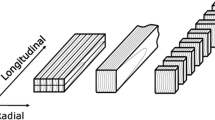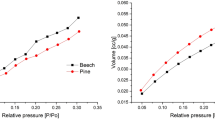Abstract
In this work, densities and porosity parameters are determined on domestic and overseas soft- and hardwoods by application of pycnometric methods and mercury intrusion porosimetry (MIP). Great variability was found in bulk density, porosity and in the specific surface area. According to the pore size distribution, four pore size classes could be distinguished: macropores (radius 58–2 μm and 2–0.5 μm), mesopores (500–80 nm), and micropores (80–1.8 nm). The pore size distribution can vary even in the case of comparable pore volumes. The hardwoods, particularly the European diffuse-porous ones, show a higher amount of micropores, which represent the microvoids or cell wall capillaries. A high cumulative pore volume can also be the result of a high content of micropores with poorer accessibility. The value of the total specific surface area from MIP measurements is, generally, below those values obtained by the water vapour adsorption technique. These results can provide information for further investigations on the sorption behaviour and the fluid intake as technological characteristics in industrial processes of impregnation and penetration of coating materials or adhesives.
Zusammenfassung
Im Rahmen der vorliegenden Arbeit wurden an ausgewählten einheimischen und überseeischen Nadel- und Laubhölzern mit pyknometrischen Methoden und der Quecksilberdruckporosimetrie verschiedene Dichte- und Porositätsparameter bestimmt. Große Unterschiede wurden in der Normal-Rohdichte, der Porosität und Porengrößenverteilung sowie in der spezifischen Oberfläche gefunden.
Anhand der Porengrößenverteilungskurven können vier Porenklassen unterschieden werden: Makroporen (Radius 58–2 μm und 2–0,5 μm), Mesoporen (500–80 nm) sowie Mikroporen (80–1,8 nm). Laubhölzer, insbesondere die untersuchten europäischen Zerstreutporigen, zeigen einen höheren Anteil an Mikroporen. Auch bei vergleichbarem totalem Porenvolumen kann die Porengrößenverteilung variieren. Ein vergleichsweise hohes kumulatives Porenvolumen kann auch durch einen hohen Anteil an Mikroporen mit niedrigerer Zugänglichkeit verursacht werden. Die aus den Daten der Druckporosimetrie bestimmte spezifische Oberfläche ist im Allgemeinen kleiner als die mittels Wasserdampfadsorption gemessene. Die vorgestellten Ergebnisse liefern Informationen für weitergehende Untersuchungen zum Sorptions- und Eindringverhalten von Flüssigkeiten in industriellen Prozessen der Imprägnierung, Beschichtung und Verklebung.









Similar content being viewed by others
References
Beckwith III JR (1997) Separating certain species-groups of woods for identification, based on readily visible characteristics. Warnell School of Forest Resources (Wood Products). Online version: http://warnell.forestry.uga.edu/service/library/for97-193/for97-193.html
Dieste A, Krause A, Mai C, Sébe G, Militz H (2009) Modification of Fagus sylvatica L with 1,3-dimethylol-4,5-dihydroxy ethylene urea (DMDHEU) Part 2: Pore size distribution determined by differential scanning calorimetry. Holzforschung 63(1):89–93
Hösli JP, Orfila C (1985) Mercury porosimetric approach on the validity of Darcy’s law in the axial penetration of wood. Wood Sci Technol 19:347–352
Junghans K, Niemz P, Bächle F (2005) Untersuchungen zum Einfluss der thermischen Vergütung auf die Porosität von Fichtenholz. Holz Roh-Werkst 63(3):243–344
Kollmann F (1987) Poren und Porigkeit in Hölzern. Holz Roh-Werkst 45(1):1–9
Lowell S, Shields JE, MA Thomas, Thommes M (2004) Characterization of porous solids and powders: surface area, pore size and density. Kluwer Academic, Dordrecht
Pfriem A, Zauer M, Wagenführ A (2009) Alteration of the pore structure of spruce (Picea abies (L.) Karst.) and maple (Acer pseudoplatanus L.) due to thermal treatment as determined by helium pycnometry and mercury intrusion porosimetry. Holzforschung 63:94–98
Popper R, Niemz P (2009) Wasserdampfsorptionsverhalten ausgewählter heimischer und fremdländischer Holzarten. Bauphysik 31(2):117–121
Raczkowski J, Stempien C (1967) Zur Beziehung zwischen der Rohdichte und der Reindichte von Holz. Holz Roh-Werkst 25(10):380–383
Schneider A (1979) Beitrag zur Porositätsanalyse von Holz mit dem Quecksilber-Porosimeter. Holz Roh-Werkst 37(8):295–302
Schneider A (1983) Untersuchungen über die Eignung der Quecksilber-Porosimetrie zur Beurteilung der Imprägnierbarkeit von Holz. Holz Roh-Werkst 41(3):101–107
Schneider A, Wagner L (1974) Bestimmung der Porengrössenverteilung in Holz mit dem Quecksilber-Porosimeter. Holz Roh-Werkst 32(6):216–224
Schoch W, Heller I, Schweingruber FH, Kienast F (2004) Wood anatomy of central European Species. Online version: http://www.woodanatomy.ch
Siau JF (1995) Influence of moisture on physical properties. Department of Wood Science: and Forest Products, Virginia Tech
Stamm AJ (1964) Wood and cellulose science. Ronald Press, New York
Stayton CL, Hart CA (1965) Determining pore size distribution in softwoods with a mercury porosimeter. For Prod J 15:435–440
Wagenführ R (2007) Holzatlas. Fachbuchverlag im Carl Hanser Verlag, Leipzig
Washburn EW (1921) Note on a method of determining the distribution of pore sizes in a porous material. Proc Natl Acad Sci 7:115–116
Acknowledgements
We thank Beat Hornung (ETH Zurich, Institute for Geotechnical Engineering) for help in MIP measurements.
Author information
Authors and Affiliations
Corresponding author
Rights and permissions
About this article
Cite this article
Plötze, M., Niemz, P. Porosity and pore size distribution of different wood types as determined by mercury intrusion porosimetry. Eur. J. Wood Prod. 69, 649–657 (2011). https://doi.org/10.1007/s00107-010-0504-0
Received:
Published:
Issue Date:
DOI: https://doi.org/10.1007/s00107-010-0504-0




